#d. n. mukherjee
Text

53 years of #Anand (12/03/1971)
"Kahin Door Jab Din Dhal Jaye,
Sanjh Ki Dulhan Badan Churaye
Chupke Se Aaye,
Mere Khayaalon Ke Aangan Mein, Koi Sapnon Ke Deep Jalaaye"
A must-watch among #HrishikeshMukherjee's masterpieces is the movie 'Anand,' starring #RajeshKhanna and #AmitabhBachchan in the lead roles. The screenplay was a collaborative effort by Bimal Dutta, #Gulzar, D.N. Mukherjee, Hrishikesh Mukherjee, and Biren Tripathy. Music by Salil Chowdhury The lyrics were penned by #Gulzar and Yogesh, with #Gulzar also writing the poignant poem 'Maut Tu Ek Kavita Hai,' which is narrated by Amitabh Bachchan. What are your favorite songs or dialogues from the movie?
What are your favourite songs/dialogue from the movie?
#bollywoodirect#bollywood#Anand (1971)#amitabh bachchan#rajesh khanna#hrishikesh mukherjee#gulzar#yogesh#d. n. mukherjee#biren tripathy#bimal dutta#salil chowdhury
7 notes
·
View notes
Text
Kajol

This Biography is about one of the best celebrity of the world Kajol including his Height, weight,Age & Other Detail...
Express info
Real Name
Kajol Mukherjee Devgan
Nick Name
Kads
Profession
Actress
Age (as in 2023)
48 Years old
Physical Stats & More Info
Height
in centimeters- 161 cm
in meters- 1.61 m
in Feet Inches- 5' 3”
Weight
in Kilograms- 57 kg
in Pounds- 126 lbs
Figure Measurements
35-27-34
Eye Color
Hazel
Hair Color
Black
Personal Life of Kajol
Date of Birth
5 August 1974
Birth Place
Mumbai, Maharashtra, India
Nationality
Indian
Hometown
Mumbai, Maharashtra, India
School
St. Joseph's Convent School, Panchgani, Maharashtra
College
N/A
Education Qualifications
School dropout
Debut
Film Debut: Bekhudi (1992)
Family
Father- Late Shomu Mukherjee (Filmmaker)
Mother- Tanuja (Actress)
Brother- N/A
Sister- Tanishaa Mukherjee (Younger, Actress)
Best Friends
Shah Rukh Khan
Religion
Hindu
Home Address
1. 5/6, Sheetal Apartments, Ground Floor, Opposite Chandan Cinema, Juhu, Mumbai.
2. 45/D Malgari Road, Mumbai.
Hobbies
Reading and knitting
Like & DisLike
N/A
Favourite Things Of Kajol
Favourite Food
Pizza, Spaghetti Salad with Olives and French Fries
Favourite Actress
Sridevi
Favourite Actor
Ajay Devgan and Shah Rukh Khan
Favourite Colors
White
Favourite Film
Bollywood: Sholay, Chaalbaaz
Hollywood: Casablanca, Ironman 3, Gone With The Wind
Favourite Sports
Tennis, Football
Favourite Perfume
Cool Waters
Favourite Music
Old Hindi film songs...
Favourite Destination
Europe
Favourite Book
Notes to Myself: My Struggle to Become a Person by Hugh Prather
Boys , Affairs and More Of Kajol
Marital Status
Married
Affairs
Karthik
Ajay Devgan (Actor)
Marriage Date
24 February 1999
Husband
Ajay Devgan, Actor (1999-present)
Children
Daughter- Nysa
Son- Yug
Style Of Kajol
Cars Collection
Mercedes Benz SUV
Bikes Collection
N/A
Earning Money of Kajol
Net Worth
$16 million
Salary per Film
9-12 crore/film (INR)
This Biography written by www.welidot.com
Read the full article
2 notes
·
View notes
Text
THE 150 GREATEST (FORMAL & INFORMAL) PERSONALITIES IN THE KNOWN HISTORY/COLLECTIVE CONSCIOUSNESS OF INDIA !
(THE FREE-FOR-ALL LIST, NOT RESTRICTED TO PADMA AWARDEES OR STAMP HOLDERS, EVEN IF INCL A MAJORITY OF THEM )
Ie. THE 150 GREATEST PEOPLE IN INDIAN HISTORY !
Rajesh Khanna
C.V. Raman
Online Indie
Jayaprakash Narayan
J.R.D. Tata
Subhash Chandra Bose
Swami Vivekananda
Lal Bahadur Shastri
Srinivasa Ramanujam
Bhagwan Sri Sathya Sai Baba
Valmiki
Bhagwan Shri Shirdi Sai Baba
Ramakrishna Paramhansa
Bhagwan Shiva
Bhagwan Ganesha
Mata Parvati / Amma Karunamayi
Bhagwan Krishna
Bhagwan Ram
Bhagwan Mahavira
Maharana Pratap
Jagadish Chandra Bose
Major Dhyan Chand
Govind Ballabh Pant
Lala Lajpat Rai
Dhirubhai Ambani
Meena Kumari
Mother Teresa
Chhatrapati Shivaji
Bal Gangadhar Kher
Madan Mohan Malviya
Kishore Kumar
Dr. Sarvapalli Radhakrishnan
Dr. Bhagwan Das
Guru Nanak
Allama Mashriqi
Lokmanya Tilak
Tansen
Lord Hanuman
Vithalbhai Patel
Atal Behari Vajpayee
P.U.M. Thevar
Nandlal Bose
Rabindranath Tagore
Dr. Babasaheb Ambedkar
Prem Chand
Jesus Christ
Adi Shankaracharya
K. L. Saigal
N. T. Ramarao
Dr. Devi Prasad Shetty
B. R. Chopra
Viswanathan Anand
Sri Aurobindo
Rani Laxmibai
Chakravarti Rajagopalachari
Narendra Modi
Milkha Singh
Mirza Ghalib
Dr. K.S. Krishnan
Dr. Satyendra Nath Bose
Dr. Zakir Hussain
Dr. M. Visvesvaraiya
Satyajit Ray
Bankim Chandra Chatterjee
Ramana Maharishi
Radha (Ancient Krishna devotee)
Chandulal Madhavlal Trivedi
Mahatma Jyotirao Phule
Savitribai Phule
Lt. Col. Maharaj Kumar Namgyal
Shammi Kapoor
Indira Gandhi
Dev Anand
Jijabai
Sadhu Vaswani
Raja Ravi Varma
Saiyid Fazl Ali
Ashok Kumar
Dr. Madhav Shrihari Aney
Gopal Das Neeraj
Ajudhia Nath Khosla
Shashi Kapoor
Ustad Bade Ghulam Ali Khan
Dr. Arcot Lakshmanaswami Mudaliar
Bipin Chandra Pal
Dr. Jnan Chandra Ghosh
Paramhansa Yogananda
Thiruvallavur
Buddha
Maharishi Patanjali
Dr. Nambi Narayanan
Dr. Verghese Kurien
Dadasaheb Phalke
Arjun (of Gita)
Waheeda Rehman
Dr. P.V. Kane
Jigme Dorji Wangchuk
Veer Savarkar
Thakkar Bapa
Ahilyabai Holkar
Rash Behari Bose
Sane Guruji
Maharishi Mahesh Yogi
Swami Ranganathananda
Dr. Shanti Swarup Bhatnagar
M. S. Subbalakshmi
Dr. Satish Dhawan
Chaitanya Mahaprabhu
Surdas
A. Ramaswamy Mudaliar
Mohandas Karamchand Gandhi
Prafulla Chandra Roy
Kabir (pre-independence poet)
Zubin Mehta
Kalidasa
Suchitra Sen
Tyagaraja
M. G. Ramachandran
Dr. Prabha Atre (classical singer)
Kavi Pradeep
Pt. Kishan Maharaj (tabla)
R.K. Laxman
Mirabai
Tulsidas
Uttam Kumar
Dr. K. Kasturirangan
Ashfaqullah Khan
Dr. Dhondo Keshav Karve
Ram Prasad Bismil
Chandrashekhar Azad
Tenzing Norgay
N.R. Narayana Murthy
Kumaran Asan
Bhai Vir Singh
Dr. Shyama Prasad Mukherjee
Dr. John Matthai
Subramanya Bharati
Pt. Omkarnath Thakur
Emperor Indravarman (of Srivijaya Empire (7th c – 12th c))
Vaidyaraj Sushil Kumar Jain (Jaipur, present day)
Sant Tukaram
Emperor Lalitaditya Muktapida (of Karakota Empire(7th c–9thc))
Peshwa Balaji Vishwanath (Maratha Empire)
Emperor Akbar (Mughal Empire)
Laxmikant-Pyarelal
R.D. Burman
Shankar-Jaikishan
S. D. Burman
Manoj Kumar
Mohammad Rafi .





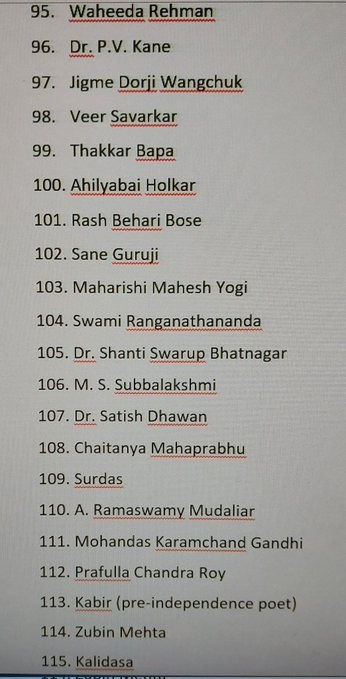



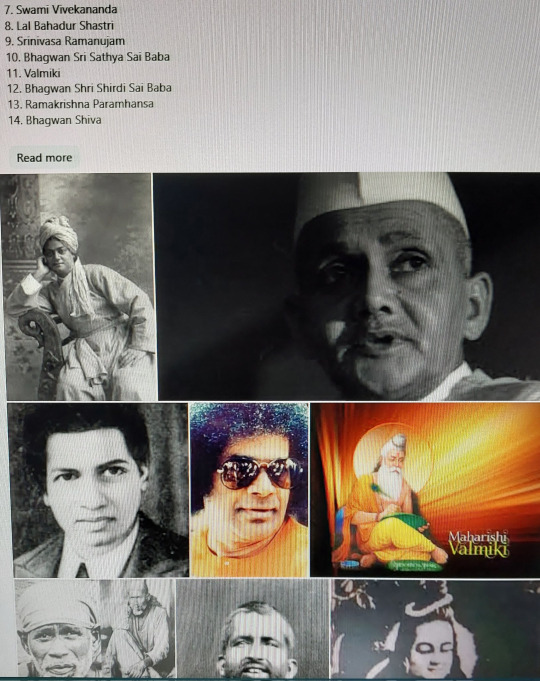
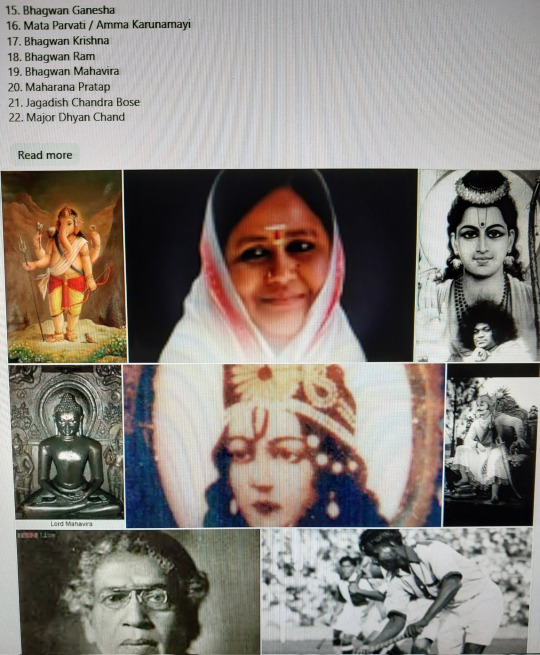



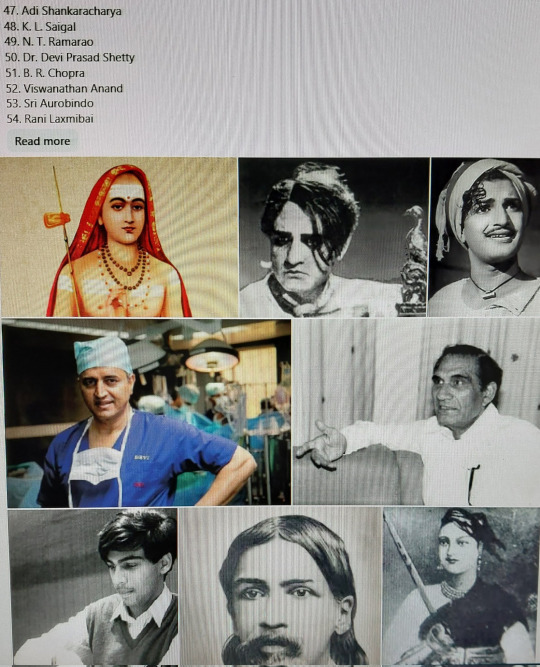




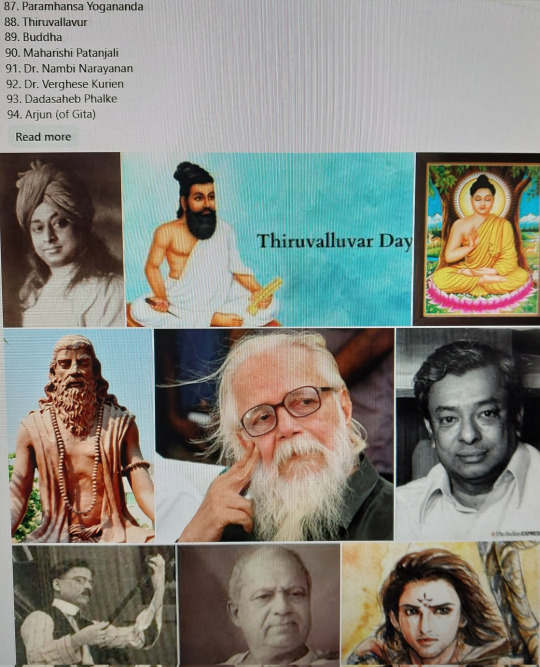



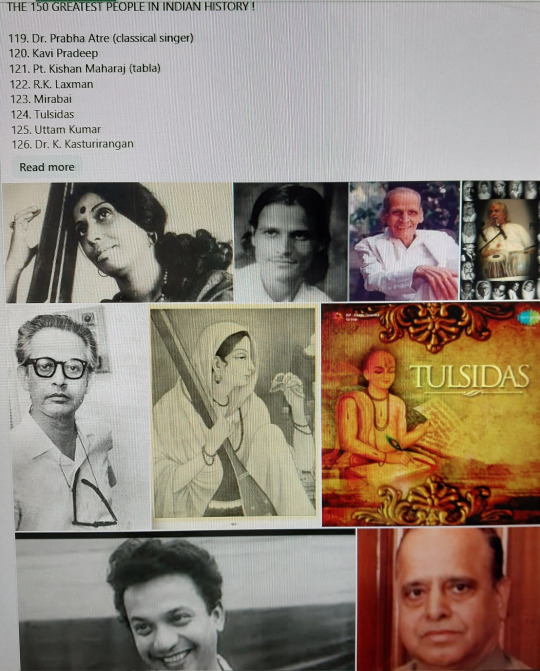
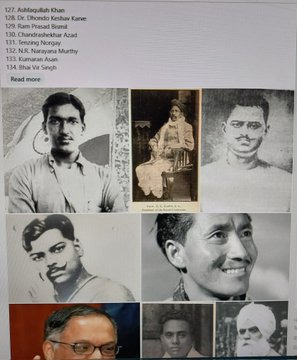
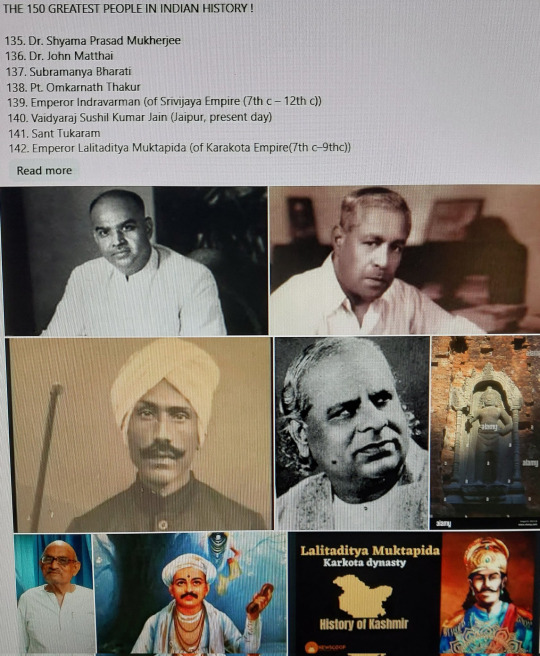

1 note
·
View note
Text
THE 150 GREATEST (FORMAL & INFORMAL) PERSONALITIES IN THE KNOWN HISTORY/COLLECTIVE CONSCIOUSNESS OF INDIA !
(THE FREE-FOR-ALL LIST, NOT RESTRICTED TO PADMA AWARDEES OR STAMP HOLDERS, EVEN IF INCLUDING A MAJORITY OF THEM )
Full List-
.Online Indie
.Rajesh Khanna
.C.V. Raman
.Jayaprakash Narayan
.J.R.D. Tata
.Subhash Chandra Bose
.Swami Vivekananda
.Lal Bahadur Shastri
.Srinivasa Ramanujam
.Bhagwan Sri Sathya Sai Baba
.Valmiki
.Bhagwan Shri Shirdi Sai Baba
.Ramakrishna Paramhansa
.Bhagwan Shiva
.Bhagwan Ganesha
.Mata Parvati
.Bhagwan Krishna
.Bhagwan Ram
.Bhagwan Mahavira
.Maharana Pratap
.Jagadish Chandra Bose
.Major Dhyan Chand
.Govind Ballabh Pant
.Lala Lajpat Rai
.Dhirubhai Ambani
.Meena Kumari
.Mother Teresa
.Chhatrapati Shivaji
.Bal Gangadhar Kher
.Madan Mohan Malviya
.Kishore Kumar
.Dr. Sarvapalli Radhakrishnan
.Dr. Bhagwan Das
.Guru Nanak
.Allama Mashriqi
.Lokmanya Tilak
.Tansen
.Lord Hanuman
.Vithalbhai Patel
.Atal Behari Vajpayee
.P.U.M. Thevar
.Nandlal Bose
.Rabindranath Tagore
.Dr. Babasaheb Ambedkar
.Prem Chand
.Jesus Christ
.Adi Shankaracharya
.K. L. Saigal
.N. T. Ramarao
.Dr. Devi Prasad Shetty
.B. R. Chopra
.Viswanathan Anand
.Sri Aurobindo
.Rani Laxmibai
.Chakravarti Rajagopalachari
.Narendra Modi
.Milkha Singh
.Mirza Ghalib
.Dr. K.S. Krishnan
.Dr. Satyendra Nath Bose
.Dr. Zakir Hussain
.Dr. M. Visvesvaraiya
.Satyajit Ray
.Bankim Chandra Chatterjee
.Ramana Maharishi
.Radha (Ancient Krishna devotee)
.Chandulal Madhavlal Trivedi
.Mahatma Jyotirao Phule
.Savitribai Phule
.Lt. Col. Maharaj Kumar Namgyal
.Shammi Kapoor
.Indira Gandhi
.Dev Anand
.Jijabai
.Sadhu Vaswani
.Raja Ravi Varma
.Saiyid Fazl Ali
.Ashok Kumar
.Dr. Madhav Shrihari Aney
.Gopal Das Neeraj
.Ajudhia Nath Khosla
.Shashi Kapoor
.Ustad Bade Ghulam Ali Khan
.Dr. Arcot Lakshmanaswami Mudaliar
.Bipin Chandra Pal
.Dr. Jnan Chandra Ghosh
.Paramhansa Yogananda
.Thiruvallavur
.Buddha
.Maharishi Patanjali
.Dr. Nambi Narayanan
.Dr. Verghese Kurien
.Dadasaheb Phalke
.Arjun (of Gita)
.Waheeda Rehman
.Dr. P.V. Kane
.Jigme Dorji Wangchuk
.Veer Savarkar
.Thakkar Bapa
.Ahilyabai Holkar
.Rash Behari Bose
.Sane Guruji
.Maharishi Mahesh Yogi
.Swami Ranganathananda
.Dr. Shanti Swarup Bhatnagar
.M. S. Subbalakshmi
.Dr. Satish Dhawan
.Chaitanya Mahaprabhu
.Surdas
.A. Ramaswamy Mudaliar
.Mohandas Karamchand Gandhi
.Prafulla Chandra Roy
.Kabir (pre-independence poet)
.Zubin Mehta
.Kalidasa
.Suchitra Sen
.Tyagaraja
.M. G. Ramachandran
.Dr. Prabha Atre (classical singer)
.Kavi Pradeep
.Pt. Kishan Maharaj (tabla)
.R.K. Laxman
.Mirabai
.Tulsidas
.Uttam Kumar
.Dr. K. Kasturirangan
.Ashfaqullah Khan
.Dr. Dhondo Keshav Karve
.Ram Prasad Bismil
.Chandrashekhar Azad
.Tenzing Norgay
.N.R. Narayana Murthy
.Kumaran Asan
.Bhai Vir Singh
.Dr. Shyama Prasad Mukherjee
.Dr. John Matthai
.Subramanya Bharati
.Pt. Omkarnath Thakur
.Emperor Indravarman (of Srivijaya Empire (7th c – 12th c))
.Vaidyaraj Sushil Kumar Jain (Jaipur, present day)
.Sant Tukaram
.Emperor Lalitaditya Muktapida (of Karakota Empire(7th c–9thc))
.Peshwa Balaji Vishwanath (Maratha Empire)
.Emperor Akbar (Mughal Empire)
.Laxmikant- Pyarelal
.R.D. Burman
.Shankar- Jaikishan
.S. D. Burman
.Manoj Kumar
.Mohd Rafi






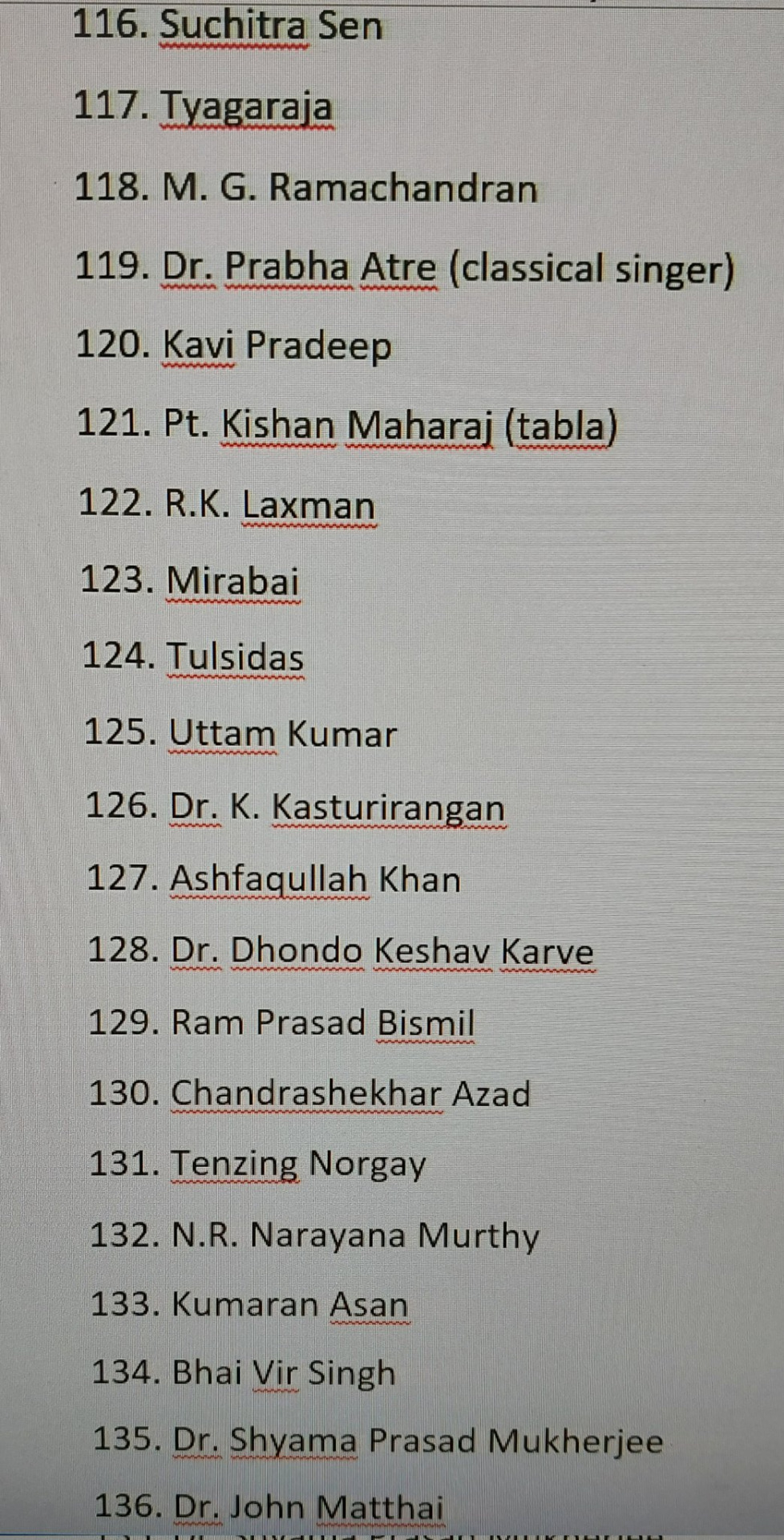
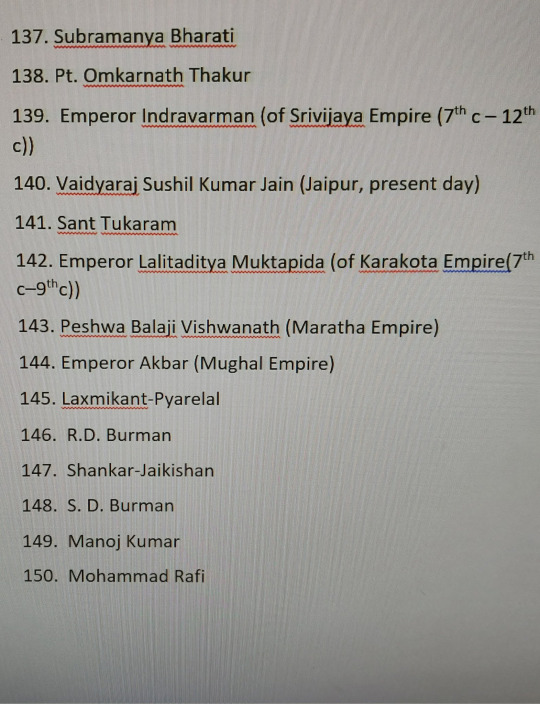




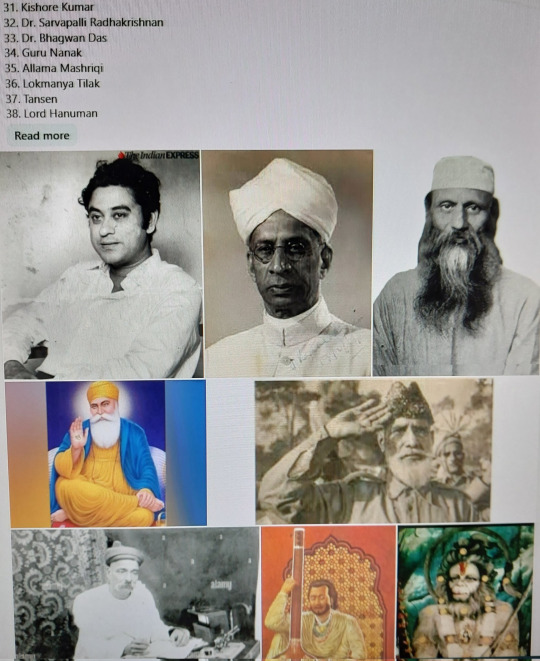
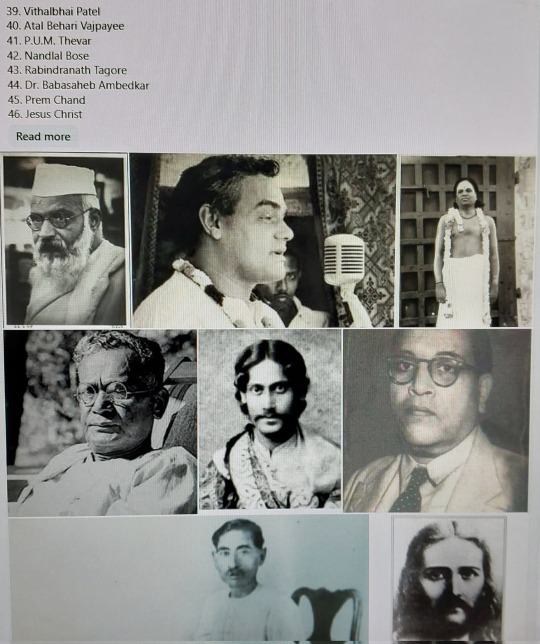

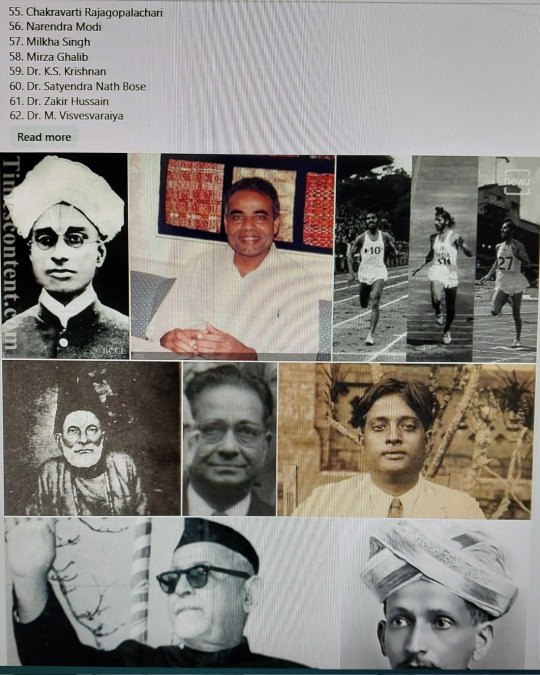

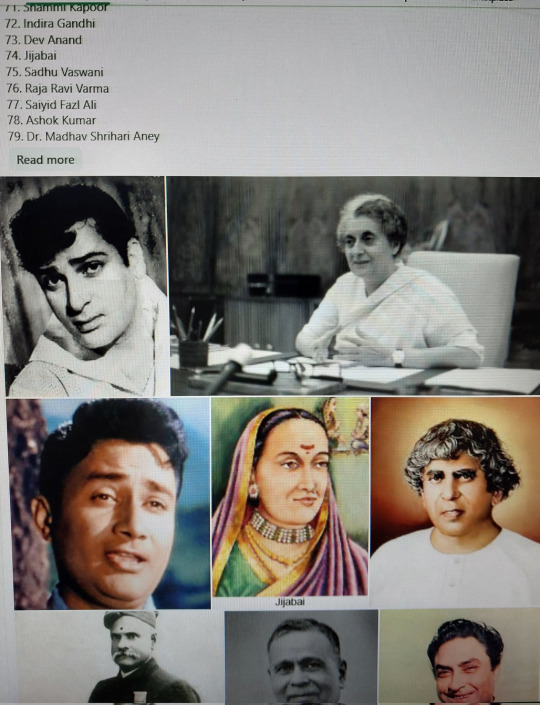





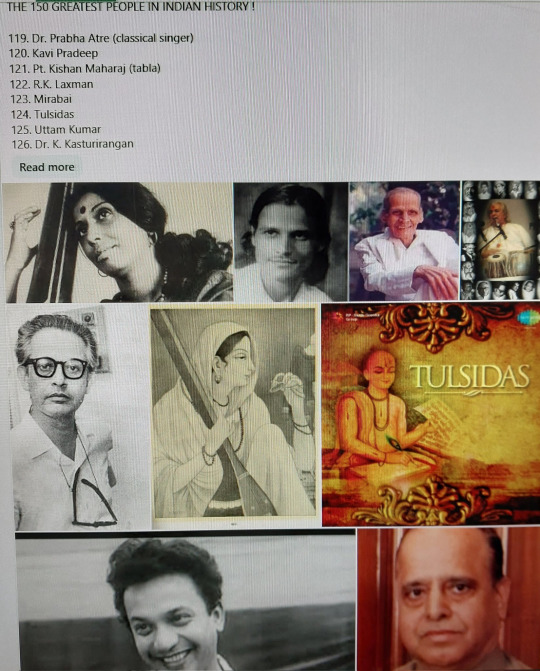



1 note
·
View note
Text
Interesting Papers for Week 23, 2022
Feedforward and feedback influences through distinct frequency bands between two spiking-neuron networks. Dalla Porta, L., Castro, D. M., Copelli, M., Carelli, P. V., & Matias, F. S. (2021). Physical Review E, 104(5), 054404.
Medial Entorhinal Cortex Excitatory Neurons Are Necessary for Accurate Timing. Dias, M., Ferreira, R., & Remondes, M. (2021). Journal of Neuroscience, 41(48), 9932–9943.
Recruitment and inhibitory action of hippocampal axo-axonic cells during behavior. Dudok, B., Szoboszlay, M., Paul, A., Klein, P. M., Liao, Z., Hwaun, E., … Soltesz, I. (2021). Neuron, 109(23), 3838-3850.e8.
Sleep replay reveals premotor circuit structure for a skilled behavior. Elmaleh, M., Kranz, D., Asensio, A. C., Moll, F. W., & Long, M. A. (2021). Neuron, 109(23), 3851-3861.e4.
Attention controls multisensory perception via two distinct mechanisms at different levels of the cortical hierarchy. Ferrari, A., & Noppeney, U. (2021). PLOS Biology, 19(11), e3001465.
Memories in a network with excitatory and inhibitory plasticity are encoded in the spiking irregularity. Gallinaro, J. V., & Clopath, C. (2021). PLOS Computational Biology, 17(11), e1009593.
Diverse processing underlying frequency integration in midbrain neurons of barn owls. Gorman, J. C., Tufte, O. L., Miller, A. V. R., DeBello, W. M., Peña, J. L., & Fischer, B. J. (2021). PLOS Computational Biology, 17(11), e1009569.
An implicit representation of stimulus ambiguity in pupil size. Graves, J. E., Egré, P., Pressnitzer, D., & de Gardelle, V. (2021). Proceedings of the National Academy of Sciences, 118(48), e2107997118.
Causal inference regulates audiovisual spatial recalibration via its influence on audiovisual perception. Hong, F., Badde, S., & Landy, M. S. (2021). PLOS Computational Biology, 17(11), e1008877.
Nonlinear visuoauditory integration in the mouse superior colliculus. Ito, S., Si, Y., Litke, A. M., & Feldheim, D. A. (2021). PLOS Computational Biology, 17(11), e1009181.
Dissecting cascade computational components in spiking neural networks. Jia, S., Xing, D., Yu, Z., & Liu, J. K. (2021). PLOS Computational Biology, 17(11), e1009640.
A confirmation bias in perceptual decision-making due to hierarchical approximate inference. Lange, R. D., Chattoraj, A., Beck, J. M., Yates, J. L., & Haefner, R. M. (2021). PLOS Computational Biology, 17(11), e1009517.
Active strategies for multisensory conflict suppression in the virtual hand illusion. Lanillos, P., Franklin, S., Maselli, A., & Franklin, D. W. (2021). Scientific Reports, 11, 22844.
Sensory coding and contrast invariance emerge from the control of plastic inhibition over emergent selectivity. Larisch, R., Gönner, L., Teichmann, M., & Hamker, F. H. (2021). PLOS Computational Biology, 17(11), e1009566.
Thalamic circuits for independent control of prefrontal signal and noise. Mukherjee, A., Lam, N. H., Wimmer, R. D., & Halassa, M. M. (2021). Nature, 600(7887), 100–104.
The dynamics of decision-making and action during active sampling. Ozbagci, D., Moreno-Bote, R., & Soto-Faraco, S. (2021). Scientific Reports, 11, 23067.
Rational regulation of water-seeking effort in rodents. Reinagel, P. (2021). Proceedings of the National Academy of Sciences, 118(48), e2111742118.
Temporal order of signal propagation within and across intrinsic brain networks. Veit, M. J., Kucyi, A., Hu, W., Zhang, C., Zhao, B., Guo, Z., … Parvizi, J. (2021). Proceedings of the National Academy of Sciences, 118(48), e2105031118.
Self-organization of a doubly asynchronous irregular network state for spikes and bursts. Vercruysse, F., Naud, R., & Sprekeler, H. (2021). PLOS Computational Biology, 17(11), e1009478.
Developmental Regulation of Homeostatic Plasticity in Mouse Primary Visual Cortex. Wen, W., & Turrigiano, G. G. (2021). Journal of Neuroscience, 41(48), 9891–9905.
#science#Neuroscience#computational neuroscience#Brain science#research#cognition#cognitive science#neurons#neural networks#neural computation#neurobiology#psychophysics
8 notes
·
View notes
Text
Shringasaurus indicus
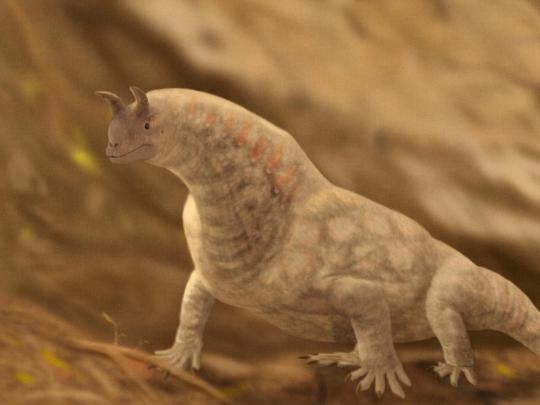
By Stolp
Etymology: Horned Reptile
First Described By: Sengupta, Ezcurra & Bandyopadhyay, 2017
Classification: Biota, Archaea, Proteoarchaeota, Asgardarchaeota, Eukaryota, Neokaryota, Scotokaryota Opimoda, Podiata, Amorphea, Obazoa, Opisthokonta, Holozoa, Filozoa, Choanozoa, Animalia, Eumetazoa, Parahoxozoa, Bilateria, Nephrozoa, Deuterostomia, Chordata, Olfactores, Vertebrata, Craniata, Gnathostomata, Eugnathostomata, Osteichthyes, Sarcopterygii, Rhipidistia, Tetrapodomorpha, Eotetrapodiformes, Elpistostegalia, Stegocephalia, Tetrapoda, Reptiliomorpha, Amniota, Sauropsida, Eureptilia, Romeriida, Diapsida, Neodiapsida, Sauria, Archosauromorpha, Crocopoda, Allokotosauria, Azendohsauridae
Status: Extinct
Time and Place: Between 247.2 to 242 million years ago, in the Anisian of the Middle Triassic
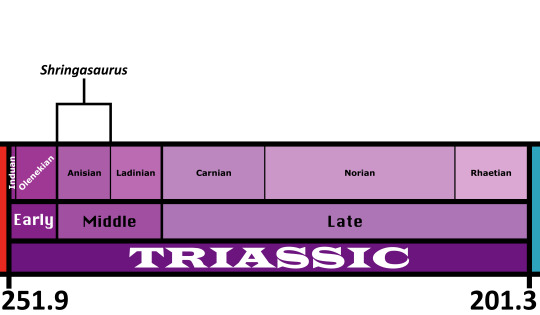
Shringasaurus is known from the Denwa Formation in Madhya Pradesh, India

Physical Description: Shringasaurus is a very strange looking reptile (befitting of the allokotosaur title), and basically looks like one of those retro ‘slurpasaurs’ from those old dinosaur movies where they just glued horns onto an iguana. At around 3–4 metres long, Shringasaurus was pretty large for a Middle Triassic archosauromorph, and could have potentially stood tall enough to look you in the eye. Shringasaurus had some very unusual proportions, with a small blunt-snouted head on a long, very thick neck attached to some very deep shoulders with tall withers over them. These chunky forequarters contrast with its rear end, with proportionately small hips and a tail that is relatively short compared to other stem-archosaurs. Of course, its most famous features are its bizarre horns over its eyes. These are remarkably similar to the horns of ceratopsid dinosaurs like Triceratops, and are yet another fabulous example of the Triassic doing everything dinosaurs did first. These horns can be as tall as the skull again in large individuals, and curve to face up and forwards. These horns were proportionately smaller in younger animals, and so likely grew in as they matured. Interestingly, one juvenile specimen lacks horns at all, even though a similar sized specimen has them, suggesting that some Shringasaurus, possibly females, didn’t have them. Even on closer inspection Shringasaurus is weird. For instance, it has palatal teeth like some other reptiles, but lots of them, and they’re all shaped exactly like the teeth on the edges of its jaws. No other reptile besides it and its close relative Azendohsaurus have teeth like that. Just imagine how that would look when it opened its mouth.
Shringasaurus embodies the typical azendohsaurid body plan of combining bizarrely ‘advanced’ sauropod-like traits with those of more ‘primitive’ archosauromorphs. Its long neck and small head has obvious superficial similarities, but features of its jaws and teeth are so sauropod-like that they’re only seen in sauropods themselves and azendohsaurids like Shringasaurus—yet another remarkable example of convergent evolution in these animals. Features of its arms are similar to sauropodomorphs too, but its posture was decidedly more ‘primitive’ than them. Its back legs sprawled completely, like those of a lizard, and while the front legs weren’t anything as upright as sauropods, they may still have been held more off the ground in a sort of semi-sprawl than the back ones. This would have given Shringasaurus a sloped back and raised the head and neck higher above its shoulders, so in a way it was still superficially sauropod-like. With horns.
Diet: Shringasaurus was clearly a herbivore from the shape of its teeth, which are leaf-shaped and serrated (indistinguishable from herbivorous dinosaur teeth, infact). The teeth and jaws of its close relative of Azendohsaurus have been studied in detail, and suggest it preferred feeding on the softer parts of plants like leaves rather than tough stems and branches. Shringasaurus had similar teeth, so it likely fed on soft vegetation also. Quite how it used its freaky palatal teeth is anyone’s guess.
Behavior: Not much can be said for sure about its behaviour, but since so many Shringasaurus individuals were found together of different ages, it’s possible that they lived in mixed-aged herds. Sexual dimorphism, if really present, would be a good indicator that the horns were used at least for display, but like the horns of ceratopsids and living bovids it’s also possible they were used in combat, locking their horns in jousts to settle disputes over food, mates, territory, or anything else they might have been grumpy over. The shape of the horns in particular implies they were mostly likely used for this kind of wrestling.
Ecosystem: Shringasaurus co-existed with a decent variety of other typical mid-Triassic animals in the Denwa Formation. Other large herbivores included two dicynodonts, one a stahleckeriine and the other more like the older Kannemeyeria, as well as an early rhynchosaurid. No less than four temnospondyl amphibians are known from there, including the predatory Cherninia and Paracyclotosaurus crookshanki, a brachyopoid (think Koolasuchus), and a long-snouted gharial-like trematosaurid. The extinct lungfish Ceratodus was also swimming around here too. Shringasaurus was one of the largest animals known in this ecosystem, and probably would have only rubbed shoulders with the large stahleckeriine dicynodont for food sources, browsing on tall, lush plants out of reach of the other herbivores. The environment was a broad, semi-arid floodplain with slow meandering rivers, subject to seasonal rainfall and droughts that may have periodically dried up rivers and ponds.
Other: Shringasaurus belongs to a recently recognised group of archosauromorphs called Allokotosauria, the “strange reptiles”, which includes other peculiar stem-archosaurs like Trilophosaurus and bizarre Teraterpeton. Allokotosaurs all appear to be herbivores, and can be characterised by their strange teeth, but they’ve all got different types of them! Shringasaurus and other azendohsaurids all have jaws full of teeth (including the roof of the mouth) that look just like herbivorous dinosaur teeth. The resemblance is so uncanny that Azendohsaurus was considered to be a dinosaur for decades before the rest of its body was discovered. Trilophosaurids meanwhile have a characteristic beak, which in the unique case of Teraterpeton is so long and pointed that it vaguely resembles an anteater, and their teeth are cusped and interlocking for shearing leaves.
Early archosauromorphs used to be thought of as mostly carnivores and insectivores, while the role of large herbivores was dominated by the synapsid dicynodonts in the Early and Middle Triassic, with archosaurs like dinosaurs and aetosaurs, as well as the rhynchosaurs, only taking over in the Late Triassic. Allokotosaurs like Shringasaurus demonstrate that this was wrong, and that stem-archosaurs were just as capable of being derived herbivores capable of competing with synapsids in the Middle Triassic just as well as the later derived rhynchosaurs and archosaurs, including at large sizes as big as Shringasaurus. Intriguingly, there’s evidence to suggest that Azendohsaurus was endothermic to some degree, i.e. warm-blooded, and given their close relationship it’s probable that Shringasaurus was too. This would make azendohsaurids like Shringasaurus some of the earliest stem-archosaurs to have been warm-blooded!
~ By Scott Reid
Sources under the Cut
Bandyopadhyay, S. and Sengupta, D.P., 1999. Middle triassic vertebrates of India. Journal of African Earth Sciences, 29(1), pp.233-241
Cubo, J.; Jalil, N.-E. (2019). "Bone histology of Azendohsaurus laaroussii: Implications for the evolution of thermometabolism in Archosauromorpha". Paleobiology. 45 (2): 317–330
Ghosh, P., Sarkar, S. & Maulik, P. Sedimentology of a muddy alluvial deposit: Triassic Denwa Formation, India. Sedimentary Geology 191, 3–36 (2006)
Goswami, A.; Flynn, J.J.; Ranivoharimanana, L.; Wyss, A.R. (2005). "Dental microwear in Triassic amniotes: implications for paleoecology and masticatory mechanics". Journal of Vertebrate Paleontology. 25 (2): 320–329
Maulik, P. K., Chakraborty, C., Ghosh, P. & Rudra, D. Meso- and Macro-Scale architecture of a Triassic Fluvial Succession: Denwa Formation, Satpura Gondwana Basin, Madhya Pradesh. Journal Geological Society of India 56, 489–504 (2000)
Mukherjee, R.N. and Sengupta, D.P., 1998. New capitosaurid amphibians from the Triassic Denwa Formation of the Satpura Gondwana basin, central India. Alcheringa, 22(4), pp.317-327
Mukherjee, D., Sengupta, D.P. and Rakshit, N., 2019. New biological insights into the Middle Triassic capitosaurs from India as deduced from limb bone anatomy and histology. Papers in Palaeontology
Nesbitt, S.J;, Flynn, J.J.; Pritchard, A.C.; Parrish, M.J.; Ranivoharimanana, L.; Wyss, A.R. (2015). "Postcranial osteology of Azendohsaurus madagaskarensis (?Middle to Upper Triassic, Isalo Group, Madagascar) and its systematic position among stem archosaur reptiles". Bulletin of the American Museum of Natural History (398): 1–126
Robinson, P. L. 1970. The Indian Gondwana formations–a review. In First IUGS International Symposium on Gondwana Stratigraphy and Paleontology, 201–268
Sengupta, S.; Ezcurra, M.D.; Bandyopadhyay, S. (2017). "A new horned and long-necked herbivorous stem-archosaur from the Middle Triassic of India". Scientific Reports. 7: 8366
#Shringasaurus#Shringasaurus indicus#Reptile#Archosauromorph#Triassic#Triassic Madness#Triassic March Madness#Palaeoblr#Allokotosaur#Prehistoric Life#Paleontology#Prehistory
363 notes
·
View notes
Note
Hello! I was wondering if you had anything on Y Gododdin 😃
hey! fellow gododdin enthusiast! what a delight
i presume this is a request for reading recommendations - i don’t know exactly what you’re looking for, or how accessible these will be, but i’ve tried to cover most bases here. i WISH there were more literary criticism, maybe there is in the welsh-language scholarship and i just haven’t found it?
it’s entirely possible that i will have missed some obvious things here, i’m mostly sticking to stuff that i personally have read. if something mind-blowing has come out since the last time i did gododdin reading then it’s not here, i’m afraid!
but enough disclaimers. on to the recs!
text and translation:
for a translation, i cannot recommend enough joseph p. clancy’s translation as found in the triumph tree: scotland’s earliest poetry, 550-1350, ed. t. o. clancy (1998). this is fantastic. it’s poetic, it’s a joy to read, and having used it as part of a deep read last year where i went through the welsh text in detail i am honestly AMAZED regularly at how well clancy handles the many translation issues that arise. it’s loose, and it doesn’t translate every single stanza unfortunately, but for the spirit of the poem you really can’t do better
that said, if you need another translation to check against/to fill in the gaps, i’d recommend kenneth jackson’s the gododdin: the oldest scottish poem (1969). it’s a prose translation, so it’s harder to use in conjunction with the text, but it’s pretty clear and accurate
text-wise... things get complicated. honestly, the best edition is probably still ifor williams’ canu aneirin (1938), in terms of faithfulness to the words on the manuscript page. (i also really enjoy his textual commentary, but it is in modern welsh so not accessible to everyone.) the major problem with it is that you are not going to get the stanzas in the order they appear in the manuscript - he reorders them into groups of perceived variants. this also makes it harder to distinguish between the A-text and the B-text. AND it means that the stanzas are not in the same order as in any of the translations!
if you can get hold of it, i really really think it is worth having daniel huws’ llyfr aneirin: a facsimile (1989). the introduction is SO useful for understanding the manuscript context, and it comes with gwenogvryn evans’ transcription of the book of aneirin, which you can compare with williams’ edition if need be to work out where a stanza actually goes.
there’s a conspectus of editions which i think thomas owen clancy put together but i cannot for the LIFE of me remember where it is - if you think you’ll need it, PM me and i’ll see what i can do
dating, textual criticism and historicity:
t. m. charles-edwards, wales and the britons, 350-1064 (2013), chapter 11 - this is from more of a historical perspective than a strictly linguistic/palaeographical/dating perspective, but it’s a really good general introduction and i definitely recommend starting with it. if you read nothing else, read this. this whole book is a godsend
t. m. charles-edwards, 'the authenticity of the gododdin: an historian's view', in astudiaethau ar yr hengerdd, eds. bromwich and jones (1978), pp. 44-91 - this kind of lays out the standard view which everyone has been deconstructing ever since. we don’t know anything about what’s going on with y gododdin, but at one point we thought we did know something and this was what it looked like
d. n. dumville, 'early welsh poetry: problems of historicity', in early welsh poetry: studies in the book of aneirin, ed. b. f. roberts (1988) - and HERE is the deconstruction! a pretty good overview of the issues with “knowing anything” when it comes to y gododdin
p. sims-williams, 'dating the poems of aneirin and taliesin', zeitschrift für celtische philologie 36 (2016), 163-224 - i don’t have any notes on this and haven’t read it recently, but i remember it being good (it’s sims-williams so of course it is). almost certainly contains linguistics, but is probably also written readably
o. j. padel, 'aneirin and taliesin: sceptical speculations', in beyond the gododdin: dark age scotland in medieval wales, ed. a. woolf (2013), pp. 153-75 - if you can stand linguistics talk, padel does his best to make it understandable here and gives a good overview of the linguistic arguments for and against suggested dates for y gododdin. this whole book is actually very useful
g. r. isaac, 'canu aneirin awdl LI', journal of celtic linguistics 2 (1993), 65-91, AND 'readings in the history and transmission of the gododdin', cambrian medieval celtic studies 37 (1999), 55-78 - DEEP IN THE TEXTUAL CRITICISM. honestly, my poor attention span means i find it hard to pay attention all the way through these two, but if you want a really in-depth look at the possible relationships between the A and B-texts of y gododdin, this is the way to go
historical discussion and background:
charles-edwards in wales and the britons chapter 11 again
j. rowland, 'warfare and horses in the gododdin and the problem of catraeth', cambrian medieval celtic studies 30 (1995), 13-40 - this is a pretty cool look at the role of cavalry in y gododdin and while i don’t agree with all of it, i think it’s really useful reading if you’re going for a historical take on the poem
p. m. dunshea, 'the meaning of catraeth: a revised early context for y gododdin', in beyond the gododdin again, pp. 81-114 - makes some ESSENTIAL points re the question of: is catraeth catterick? moreover, IS CATRAETH A PLACE?
c. cessford, 'northern england and the gododdin poem', northern history 33 (1997), 218-22 - a historical perspective on the poem with some very useful points, comparing the situation as sketched out in y gododdin with what we know of the area at the time
m. wood, 'bernician transitions: place-names and archaeology', in early medieval northumbria: kingdoms and communities, AD 450-1100, eds. petts and turner (2011), pp. 35-70 - a welcome look at the archaeological and place-name evidence for what was going on in bernicia as it changed from a brittonic to a germanic-dominated area. really useful to have in mind both when reading the poem and when reading more literary history
r. collins, 'military communities and transformation of the frontier from the fourth to the sixth centuries', in the same book, pp. 15-34 - pretty fascinating look at the earlier background running up to the time period depicted in y gododdin, and the possibility of continuity between the roman occupation of hadrian’s wall and the post-roman era there. useful social/archaeological perspective!
f. h. clark, 'thinking about western northumbria', in the same book, pp. 113-28 - an early medieval english perspective on the area at the time, useful for comparison and completeness’ sake
literary discussion:
ifor williams, lectures on early welsh poetry (1944) and the beginnings of welsh poetry, ed. bromwich (1972, 2nd ed. 1980) - THE CLASSICS. an old-fashioned, not to say outdated, viewpoint, but that’s because this is the guy who INVENTED the viewpoint back when it was new! even now there’s a lot of good stuff packed into these and ifor williams’ prose style is a real pleasure to read. not to be missed
a. o. h. jarman, 'the heroic ideal in early welsh poetry', in beiträge zur indogermanistik und keltologie, ed. meid (1967), pp. 193-211 - likewise somewhat old-fashioned now, but lays out the classic viewpoint well and makes some good literary points. it may also be worth reading the introduction to his edition/translation, aneirin: the gododdin (1988). (i don’t recommend using it as an edition because he conflates the A and B texts and renders the text into modern welsh - this means it reads very smoothly but is quite a bit further away from what’s on the manuscript page.)
h. fulton, 'cultural heroism in the old north of britain: the evidence of aneirin's gododdin', in the epic in history ed. davidson, mukherjee and zlatar (1994), pp. 18-39 - a pretty interesting read, about the mindset expressed in the poetry, its purpose and its construction
this isn’t lit crit but i’m putting in my favourite g. r. isaac quote from his article ‘gweith gwen ystrat and the northern heroic age of the sixth century’, p. 69: ‘Koch writes that the Book of Aneirin’s ‘immediate milieu is… not the Celtic Heroic Age, but the High Middle Ages’, as if the ‘Celtic Heroic Age’ were a period of comparable historical status to the High Middle Ages. This is not the case, however. A ‘heroic age’ cannot be the ‘immediate milieu’ of any literary production, a ‘heroic age’ cannot produce literature, because a ‘heroic age’ is itself produced through literature (taken in the broadest sense). It is a literary product. The Homeric epics are not the product of a Bronze Age Achaean heroic age, but vice versa. The Irish Ulster Cycle is not the product of an Iron Age, pre-Christian heroic age, but vice versa. And the medieval Welsh poems of ‘Aneirin’ and ‘Taliesin’ (and Triads, sections of the Historia Brittonum, and much else) are not products of a sixth-century North British heroic age, but vice versa.’
honestly there just is not nearly enough lit crit for y gododdin, in english at least, especially to explain cool shit that the welsh text is doing that isn’t visible in the translation, and/or things that could be subversive or ambiguous about it - so, i don’t know what your level of engagement with the medieval welsh text is, but if you’re curious, if you want to know more about what’s going on in a specific stanza (or which stanzas are extended puns), or just which things i’ve been dying to yell about all year, PLEASE message me and I! WILL! YELL!
articles which are almost certainly good and useful but it’s been too long since i’ve read them to say:
t. o. clancy, 'the kingdoms of the north: poetry, places, politics', in beyond the gododdin again, pp. 153-75
m. haycock, 'early welsh poets look north', likewise in beyond the gododdin, pp. 115-52
FINAL NOTE:
one of the problems with translations is that they give an impression of way more certainty about the meaning of the text... than is actually there. you’re pretty safe with clancy or kenneth jackson, but tread carefully. again, i don’t know your level of engagement with medieval welsh, but if you want to know if there are any major textual issues with a stanza, hmu and i will gladly consult my copious textual notes! but in general, BEWARE of basing anything too heavily on the following groups of stanzas:
A40, A41, B5, B6 (Am drynni drylaw drylenn; Clancy ‘For the feast, most sad, disastrous’)
A42, B25, B35 (Eur ar vur caer; Clancy ‘Gold on fortress wall’)
A48, B3, B24 (Llech leutu tud leudvre; Clancy ‘Standing stone in cleared ground’)
A62, B14, B15, B16, B36 (Angor dewr daen; Clancy ‘Anchor, Deifr-router’)
the Gorchanau if you’re interacting with those, especially the Gwarchan Maeldderw - if anyone tells you they know exactly what is going on in these, do not believe them. isaac has a full translation of the gwarchan maeldderw in cambrian medieval studies 44, and it’s useful, but i’m not by ANY means completely convinced by it, so tread carefully.
the more stanzas there are in a group of variants (or at least a group that shares lines), the more likely it is that those stanzas are going to be SUPER DUPER TEXTUALLY FUCKED UP, is a pretty good rule of thumb.
#y gododdin#cicely speaks#academic book recs#asnc things#I AM SO DEEP IN THE QUESTIONABLE ETYMOLOGIES AND SADNESS ABOUT DEAD YOUNG MEN#i have PAINFULLY detailed textual notes on this whole fuckin thing#behold my continuing love affair with ifor williams' prose in welsh and english#ANYWAY#hmu for GODODDIN YELLING#it may be yelling of sadness about dead dudes! it may be yelling of frustration about FUCKING SCRIBES!#who can say!#violetcancerian
22 notes
·
View notes
Photo






52 Years of Padosan (29/11/1968)
It is directed by Jyoti Swaroop and produced by Mehmood, N. C. Sippy, and written & lyrics by Rajendra Krishan. The film stars Sunil Dutt, Saira Banu, Kishore Kumar, Mehmood, Mukri, Raj Kishore, and Keshto Mukherjee. Music by R. D. Burman.
#padosan (1968)#jyoti swaroop#n c sippy#rajendra krishan#sunil dutt#saira banu#kishore kumar#raj kishore#mukri#keshto mukherjee#bollywood#bollywoodirect
11 notes
·
View notes
Note
Hi, so I really enjoyed reading your mini dissertation on gender and nationalism. Do you possibly have an recommendations to read? I kinda was inspired to know more about it after I read your post...
Hey anon! I hope you know that I had so much fun compiling this bibliography all day (in response to this post).
I don’t know how accessible it is, or where you come from in terms of academic background—I’m a political scientist by trade who sort of stumbled into gender studies when I wasn’t paying attention. It shows in the bibliography, especially in the standard works on nationalism. Someone who is deeper into the literature on the gender side of things probably could have included standard works on gender as well, but that person is not me.
If you want to be very specific about reading, I recommend Manchanda & de Haan (2018) and Nagel (1998) for an overview. Yuval-Davis & Anthias compiled a great collection of case studies in 1989 which gives a great theoretical introduction that is very practical.
I’ve divided the bibliography into the following parts:
General readings on nationalism
General readings on nationalism and gender
Case studies on nationalism and gender
International Relations Perspective: Militarization and Gender
The last section on International Relations I’ve included because it was my first introduction to feminist political science, and I am very fond of it. It’s a little away from what I’ve discussed in the post but I find that militarization often offers a very extreme case of the intersections of nationalism and gender relations.
Lastly, I hope you can access the readings. Many of them can be found through Google Scholar, but I don’t know how many are available outside of institutions.
Standard Works on Nationalism
Anderson, B. (1989). Imagined communities: Reflections on the Origin and Spread of Nationalism. Verso.
Bhabha, H. (1990). Nation and Narration. Routledge.
Gellner, E. (1988). Nations and Nationalism. Blackwell.
Smith, A. D. (1995). Nations and Nationalism in a Global Era. Polity Press.
Works at the Theoretical Intersection of Gender and Nationalism
Manchanda, N., & de Haan, L. (2018). Gender, Nation, and Nationalism. In Race, Gender, and Culture in International Relations: Postcolonial Perspectives (pp. 80–98). Routledge.
Nagel, J. (1998). Masculinity and Nationalism: Gender and Sexuality in the Making of Nations. Ethnic and Racial Studies, 21(2), 242–269.
Peterson, V. S. (1999). Political Identities/Nationalism as Heterosexism. International Feminist Journal of Politics, 1(1), 34–65.
Vickers, J. (2011). Gender and State Architecture: The Impact of Governance Structures on Women’s Politics. Politics & Gender, 7(2), 254–262.
Yuval-Davis, N., & Anthias, F. (1989). Woman-Nation-State. Macmillan.
Case Studies on Nationalism and Gender
Ashe, F. (2007). Gendering ethno-nationalist conflict in Northern Ireland: A comparative analysis of nationalist women’s political protests. Ethnic and Racial Studies, 30(5), 766–786.
McDowell, S. (2008). Commemorating Dead ‘Men’: Gendering the Past and Present in Post-Conflict Northern Ireland. Gender, Place and Culture: A Journal of Feminist Geography, 15(4), 335–354.
Van Berkel, L., Molina, L. E., & Mukherjee, S. (2017). Gender Asymmetry in the Construction of American National Identity. Psychology of Women Quarterly, 41(3), 352–367.
Yuval-Davis, N., & Anthias, F. (1989). Woman-Nation-State. Macmillan.
International Relations Perspective: Militarization and Gender
Cockburn, C. (2010). Gender Relations as Causal in Militarization and War. International Feminist Journal of Politics, 12(2), 139–157.
Cohn, C. (1987). Sex and Death in the Rational World of Defense Intellectuals. Journal of Women in Culture and Society, 12, 687–718.
Enloe, C. (1989). Bananas, Beaches, and Bases. Making Feminist Sense of International Politics. Univer.
Tickner, J. A. (1992). Man, the State, and War: Gendered Perspectives on National Security. In Gender in International Relations. Feminist Perspectives on Achieving Global Security (pp. 27–67). Columbia University Press.
I would like to mention at the end that nationalism is shaped by more than just gender differences, even though gender differences are central. That does not mean that other differences aren’t equally important. Specifically questions of race, ethnicity, and class also play into nationalism and it’s touched on in some of the texts, but not in a central way.
#johis talks#speak friend and enter#i also want to say thank you for helping me rediscover the article on commemorating dead men
4 notes
·
View notes
Text
tagged by @yobucky thanks for the tag darling!
rules: spell out your url with song titles, answer the quarantine questions, and bold the things that apply - then tag 10 people
into the unknown - idina menzel
afeemi - sanah moidutty, jigar saraiya
maana ke hum yaar nahin - parineeti chopra
9 to 5 - dolly parton
3 am - halsey
prince ali - will smith
ev’rybody wants to be a cat - charles perry
rewrite the stars - zendaya and zac efron
can i have this dance - zac efron and vanessa anne hudgens
evacuating london - harry gregson williams
never too late - elton john
try everything - shakira
suddenly - olivia newton john
thank you for the music - amanda seyfried
angel eyes - christine baranski, julie walters, amanda seyfried
rainbow connection - gwen stefani
dil liga na - sukhbir, soham chakrabarthy, jolly mukherjee, mahalakshmi iyer, suzanne
underneath the lovely london sky - lin-manuel miranda
senorita - farhan akhtar, hrithik roshan, abhay deol, maria del mar fernandez
the fall - electric light orchestra
quarantine asks:
•where are you isolated ??
home
•what are you currently reading or watching ??
not reading much of anything. watching the last season of leverage
•if you can go outside, what do you like to do during this time ??
i can’t really go outside (well, i can but it’s florida and there are people walking around with no mask and not a care in the world) so if i do go outside, it’s at 6 in the morning when no one else is outside
•any fascinating concept you’re studying ??
yes! i’m studying how secondary organic aerosols react and bind with covid-19 and how those compounds then interact with live cells in the body, all of which i’m directing from my home while the people who are actually allowed in the lab report back to me
•what kind of acts of creativity / forms of art are you currently doing ??
i'm writing. so much. i think i’ve put out more content in the last two months than i have in the last two years. i’m also working on two lego projects
•a song that resonates with your state of mind at the moment ??
i will always return by bryan adams
•favorite impulsive / “bad” coping techniques ??
scrolling through tumblr and writing fan fiction instead of working on my research proposal
•favorite healthy / “good” coping techniques ??
drinking water and, when i find the time, working on my research proposal
.
A P P E A R A N C E
i’m over 5′5″. i wear glasses / contacts. i have blonde hair. i prefer loose clothing to tight clothing. i have one or more piercings. i have at least one tattoo. i have blue / green eyes. i have dyed or highlighted my hair (but not recently). i have gotten plastic surgery. i have or had braces. i sunburn easily. i have freckles. i paint my nails. i typically wear makeup. i don’t often smile. i am pleased with how i look. i prefer nike to adidas. i wear baseball hats backwards.
H O B B I E S A N D T A L E N T S
i play a sport. i can play an instrument. i am artistic. i know more than one language. i have won a trophy in some sort of competition. i can cook or bake without a recipe. i know how to swim. i enjoy writing. i can do origami. i prefer movies to tv shows. i can execute a perfect somersault. i enjoy singing. i could survive in the wild on my own. i have read a new book series this year. i enjoy spending time with friends. i travel during school or work breaks. i can do a handstand.
R E L A T I O N S H I P S
i am in a relationship. i have been single for over a year. i have a crush. i have a best friend i have known for ten years. my parents are together. i have dated my best friend. i am adopted. my crush has confessed to me. i have a long distance relationship. i am an only child. i give advice to my friends. i have made an online friend. i met up with someone i have met online.
A E S T H E T I C S
i have heard the ocean in a conch shell. i have watched the sunrise. i enjoy rainy days. i have slept under the stars. i meditate outside. the sound of chirping calms me. i enjoy the smell of the beach. i know what snow tastes like. i listen to music to fall asleep. i enjoy thunderstorms. i enjoy cloud watching. i have attended a bonfire. i pay close attention to colors. i find mystery in the ocean. i enjoy hiking on nature paths. autumn is my favorite season.
M I S C E L L A N E O U S
i can fall asleep in a moving vehicle. i am the mom friend. i live by a certain quote. i like the smell of sharpies. i am (was) involved in extracurricular activities. i enjoy mexican food. i can drive a stick-shift. i believe in true love. i make up scenarios to fall asleep. i sing in the shower. i wish i lived in a video game. i have a canopy above my bed. i am multiracial. i am a redhead. i own at least three dogs.
i’m pretty sure just about everyone has done this by now but tagging @crownofstardustandbone @ad1thi @furthermadness @omg-just-peachy and anyone else who wants to do this!
2 notes
·
View notes
Text
MBTI Typing Index: Names M-P
Name starts with: A B, C D, E F, G H, I J K L, M N O P, Q R S T, U V W X Y Z.
Seth MACFARLANE (ENTP)
Katie MACK (ENTP)
Emmanuel MACRON (ESTJ)
Rachel MADDOW (ENTP)
Shane MADEJ (ENTP)
Madonna / Madonna CICCONE (ESFP)
René MAGRITTE (NTP)
Rami MALEK (ISFP)
Michael MALICE (ENTP)
Terrence MALICK (INFJ)
Zayn MALICK (ISTP)
Marilyn MANSON (ISFP)
Mark MANSON (ENFJ)
Rooney MARA (ISTP)
Diego MARADONA (ESTP)
Jenna MARBLES (ESFP)
Miriam MARGOLYES (ENFP)
Julianna MARGULIES (ENTJ)
Meghan MARKLE (ENFJ)
Brit MARLING (INFJ)
Laura MARLING (INFJ)
Bruno MARS (ESFP)
Winston MARSHALL (ENTP)
Yann MARTELL (INFJ)
Chris MARTIN (INFP)
George R.R. MARTIN (INTP)
Melanie MARTINEZ (ISFP)
Karl MARX (INTJ)
Gaten MATARAZZO (ENTP)
Gabor MATÉ (INFJ)
Jim MATTIS (ESTJ)
Humberto MATURANA (INFJ)
Ava MAX (ESFP)
Theresa MAY (ESTJ)
John MAYER (ENTP)
John MCCAIN (ISTJ)
Meghan MCCAIN (ESFJ)
Paul MCCARTNEY (ESFP)
Matthew MCCONAUGHEY (ESFP)
Mitch MCCONNELL (ISTJ)
Charlie MCDONNELL (INFP)
Malcolm MCDOWELL (ESFP)
Rose MCGOWAN (ESFP)
Ian MCKELLEN (ENFP)
Ben MCKENZIE (INTJ)
Kate MCKINNON (INTP)
Seán MCLOUGHLIN (ENTP)
Adam MCKAY (ENTP)
Alexander MCQUEEN (ISFP)
Ben MENDELSOHN (INFP)
Stephen MERCHANT (ENTP)
Freddie MERCURY (ENFP)
Angela MERKEL (INTJ)
Lea MICHELE (ESFJ)
Miguel / Miguel PIMENTEL (ISFP)
Ina MOHALACHE (INTP)
Mads MIKKELSEN (ISTP)
Alyssa MILANO (ENFJ)
John Stuart MILL (INTJ)
Chanel MILLER (INFP)
Ezra MILLER (ENFP)
Gina MILLER (ENTJ)
Mac MILLER (ISFP)
Wentworth MILLER (INFJ)
Mike MILLS (INFP)
MIN Yoon-gi / SUGA (ISTP)
Nicki MINAJ (ESFP)
Anthony MINGHELLA (INFJ)
Marvin MINSKY (INTP)
Lin-Manuel MIRANDA (ENFP)
David MITCHELL (INFP)
Shay MITCHELL (ESFJ)
Hayao MIYAZAKI (INFP)
Moby / Richard HALL (INTP)
Yann MOIX (ENTP)
Jason MOMOA (ESTP)
Tana MONGEAU (ESFP)
Alan MOORE (INTP)
Mandy MOORE (ESFJ)
Caitlin MORAN (ENFP)
Dylan MORAN (INTP)
Tom MORELLO (ENFP)
Alanis MORISSETTE (ENFJ)
Chris MOROCCO (ISTJ)
Steven MORRISSEY (INFJ)
Viggo MORTENSEN (INFJ)
May-Britt MOSER (INFP)
Carrie-Anne MOSS (INFJ)
Kate MOSS (ESFP)
Bethany MOTA (ESFJ)
Wagner MOURA (ENFJ)
José MOURINHO (ISTP)
Robert MUELLER (ESTJ)
Siddhartha MUKHERJEE (INTJ)
Carey MULLIGAN (INFJ)
Marcus MUMFORD (ENFJ)
Randall MUNROE (INTP)
Eddie MURPHY (ESTP)
Bill MURRAY (ENTP)
Elon MUSK (INTP)
Dee Dee MYERS (ENTJ)
Angela NAGLE (INTJ)
Aparna NANCHERLA (INFP)
Steve NASH (INTJ)
Maajid NAWAZ (ENTJ)
Ruth NEGGA (INFJ)
Casey NEISTAT (ENTP)
Nekfeu / Ken SAMARAS (ISFP)
Maggie NELSON (INFJ)
Shirin NESHAT (INFP)
Benjamin NETANYAHU (ENTJ)
Isaac NEWTON (INTP)
Mike NIHCOLS (ENFJ)
Stevie NICKS (ESFP)
Friedrich NIETZSCHE (INFJ)
Ingrid NILSEN (ESFJ)
Anaïs NIN (INFP)
Cynthia NIXON (ENTJ)
Richard NIXON (ESTJ)
Edward NORTON (ENTP)
Graham NORTON (ENFP)
Samin NOSRAT (ENFP)
Tig NOTARO (INTP)
Amélie NOTHOMB (INFP)
BJ NOVAK (INTP)
Marti NOXON (ENFJ)
Martha NUSSBAUM (ENFJ)
Bill NYE (ENTP)
Safiya NYGAARD (ESFJ)
Jenny ODELL (INFJ)
Karen ORZOLEK (ISFP)
Conan O’BRIEN (ENTP)
James O’BRIEN (ENTJ)
Jack O’CONNELL (ESTP)
Georgia O’KEEFFE (INFP)
Shaquille O’NEAL (ESFP)
Bill O’REILLY (ESTJ)
Tyler OAKLEY (ESFP)
Joyce Carol OATES (INFP)
Barack OBAMA (ENTJ)
Michelle OBAMA (ENFJ)
Alexandria OCASIO-CORTEZ (ENFJ)
Frank OCEAN (ISFP)
Bob ODENKIRK (ENTP)
Leslie ODOM (ENFJ)
Olajide OLATUNJI (ESTP)
Jamie OLIVER (ESFP)
John OLIVER (ENTP)
Kim OLSON (ESTJ)
David OLUSOGA (INFJ)
Timothy OLYPHANT (ESTP)
Yoko ONO (ISFP)
Rita ORA (ESFP)
Orelsan / Aurélien COTENTIN (INTP)
Mallory ORTBERG (ENFP)
George ORWELL (INTJ)
Naomi OSAKA (ISFP)
Candace OWENS (ESTJ)
David OYELOWO (ENFJ)
Lee PACE (ISFP)
Chamath PALIHAPITIYA (ENTJ)
Sarah PALIN (ESFJ)
Amanda PALMER (ENFP)
Gwyneth PALTROW (ESFJ)
Larry PAGE (INTP)
Chuck PAHLANIUK (INTP)
Ellen PAO (INTJ)
Vanessa PARADIS (ISFP)
Sarah Jessica PARKER (ESFJ)
Trey PARKER (ENTP)
Dolly PARTON (ESFP)
Pedro PASCAL (ESFP)
Sara PASCOE (ENFP)
Ann PATCHETT (ENTJ)
Mandy PATINKIN (ENFP)
Robert PATTINSON (ISFP)
Jake PAUL (ESFP)
Logan PAUL (ESTP)
Sarah PAULSON (ENFP)
Alexander PAYNE (ENTJ)
Liam PAYNE (ESFJ)
Trisha PAYTAS (ESFP)
Valérie PÉCRESSE (ESTJ)
Victoria PEDRETTI (INFP)
Nancy PELOSI (ESFJ)
Sean PENN (INFP)
Louise PENTLAND (ESFP)
Simon PEGG (ENTP)
Laurie PENNY (ENFP)
Brandon PEREA (ESFP)
Esther PEREL (ENFJ)
Chelsea PERETTI (ENTP)
Katy PERRY (ESFP)
Luke PERRY (ISFP)
Matthew PERRY (ENTP)
Tyler PERRY (ENFJ)
Markus PERSSON / Notch (INTP)
Evan PETERS (ISFP)
Jordan PETERSON (ENTP)
Madelaine PETSCH (ESFJ)
Megan PHELPS-ROPER (INFJ)
Busy PHILIPPS (ESFP)
Adam PHILLIPS (INFJ)
Joaquin PHOENIX (INFP)
River PHOENIX (INFP)
Pablo PICASSO (ENFP)
Hasan PIKER (ENTP)
Pink / Alecia MOORE (ESFP)
Steven PINKER (INTP)
Scottie PIPPEN (ISFP)
Brad PITT (ISFP)
Nic PIZZOLATTO (INTJ)
Sylvia PLATH (INFP)
Aubrey PLAZA (ISTP)
Amy POEHLER (ENFP)
Benoît POELVOORDE (ENFP)
Sarah POLLEY (INFJ)
Michel POLNAREFF (INFP)
Sergei POLUNIN (ISFP)
Maria POPOVA (INFJ)
Gregg POPOVICH (INTJ)
Antoni POROWSKI (ISFP)
Natalie PORTMAN (ENFJ)
Post Malone / Austin POST (ESTP)
Will POULTER (ENFJ)
Colin POWELL (ISTJ)
Terry PRATCHETT (INTP)
Chris PRATT (ESFP)
Barbara PRAVI (ENFP)
Adam PRICE (ENFJ)
Prince / Prince NELSON (ISFP)
Jesse PRINZ (INTJ)
Florence PUGH (ESTP)
Philip PULLMAN (INFJ)
Evan PUSCHAK (INTJ)
Charlie PUTH (ESTP)
Vladimir PUTIN (ISTP)
Name starts with: A B, C D, E F, G H, I J K L, M N O P, Q R S T, U V W X Y Z.
6 notes
·
View notes
Text
Week 1 (in class readings as time allows):
Cohn, E. R., & Mullennix, J. (2007). Diversity as an integral component of college curricula. In J. Branche, J. Mullennix & E.R. Cohn (Eds.), Diversity across the curriculum: A guide for higher education faculty (pp. 11-17). San Francisco, CA: Anker Publishing.
DiAngelo, R. (2014). Leaning in: A student’s guide to engaging constructively with social justice content. Radical Pedagogy, 11(1). Retrieved from: www.radicalpedagogy.org
Week 2:
Signature Pedagogies – Short Description.
Shulman, L. (2005, Summer). Signature pedagogies in the professions. Daedalus, 52– 59.
Shulman, L. (2005, Summer). Signature pedagogies in the professions. Keynote transcript.
Week 3:
*Read Bell et. al. + three additional readings of your choice
Bell, L., Washington, S., Weinstein, G., & Love, B. (1997/2007). Knowing ourselves as instructors. In M. Adams, L. Bell, P. Griffin (Eds.), Teaching for diversity and social justice (2nd. Ed., pp. 381-393). New York, NY: Routledge.
Brueggemann, B., Garland-Thomson, R., Kleege, G. (2005). What her body taught (or teaching about and with a disability): A conversation. Feminist Studies, 31(1), 13-33.
Gorski, P. (2000). Narratives of whiteness and multicultural education. Electronic Magazine of Multicultural Education, 2(1). Retrieved from
www.edchange.org
Kirk, G., & Okozawa-Rey, M. (2010). Identities and social locations. In M. Adams, W. Blumenfeld, C. Castaneda, H. Hackman, M. Peters & X. Zuniga (Eds.), Readings for diversity and social justice (3rd Ed., pp. 9-15). New York, NY: Routledge.
Leonard, D. (2014, May 20). My life in the classroom, where race always matters. Retrieved from https://chroniclevitae.com
Lewis, M. (2011). Body of knowledge: Black queer feminist pedagogy, praxis, and embodied text. Journal of Lesbian Studies, 15(1), 49-57.
Margolis, E., & Romero, M. (2000). “In the image and likeness…” In E. Margolis (Ed.), The hidden curriculum in higher education (pp. 79-96). New York, NY: Routledge.
Mukherjee, S. (2014). Pedagogical challenges of “teaching the global.” In M. Davidson & G. Yancy (Eds.), Exploring race in predominantly white classrooms: Scholars of color reflect (pp. 181-202). New York, NY: Routledge.
Railey, K. (1998). Notes from another underground: Working-class agency and the
6
educational process. In A. Shepard, J. McMillan & G. Tate (Eds.), Coming to class: Pedagogy and the social class of teachers (pp. 170-181). Portsmouth, NH: Heinemann.
Week 4:
*Read Adams, Gonzalez, Hurtado and Ruiz + two additional readings of your choice
Adams, M., Jones, J., Tatum, B. (1997/2007). Knowing our students. In M. Adams, L. Bell, P. Griffin (Eds.), Teaching for diversity and social justice (2nd. Ed., pp. 395- 410). New York, NY: Routledge.
Blumenfeld, W. J., Weber, G. N., & Rankin, S. (2016). In our own voice: Campus climate as a mediating factor in the persistence of LGBT students, faculty, and staff in higher education. In P. Chamness Miller & E. Mikulec (Eds.), Queering classrooms: Personal narratives and educational practices to support LGBTQ youth in schools (pp. 1-20). Charlotte, NC: Information Age Publishing Inc
Gonzalez, J. (2014). How to pronounce students names and why it matters. Listen here: https://www.cultofpedagogy.com/gift-of-pronunciation/
Harper, S. (2012). Black male student success in higher education: A report from the National Black Male College Achievement Study. Philadelphia, PA: University of Pennsylvania, Center for the Study of Race and Equity in Education.
Hurtado, S., & Ruiz, A. (2015). Discrimination and bias, underrepresentation, and sense of belonging on campus. Los Angeles, CA: Higher Education Research Institute at UCLA. Retrieved from:
https://www.heri.ucla.edu/PDFs/Discriminination-and-Bias
Underrepresentation-and-Sense-of-Belonging-on-Campus.pdf
Muñoz, S. M., & Espino, M. (2017). The freedom to learn: Experiences of students without legal status attending freedom university. The Review of Higher Education, 40(4), 533-555.
Rincón, B., & George-Jackson, C. (2016). Examining department climate for women in engineering: The role of STEM interventions. Journal of College Student Development, 57(6), 742-747.
Ross-Gordon, J. M. (2011). Research on adult learners: Supporting the needs of a student population that is no longer nontraditional. Peer Review, 13(1), 26- 29.
Week 5:
*Choose two chapters from Branche et. al.
7
Branche, J., Mullennix, J., & Cohn, E. (Eds.). (2007). Diversity across the curriculum: A guide for faculty in higher education. San Francisco, CA: Jossey-Bass. Chapter 16 - Diversity and Discipline: Approaching French Literary Studies Chapter 24 – Transforming a Public Health Curriculum for the 21st Century Chapter 35 –Teaching the Business Case for Diversity
Chapter 49 – Diversity and Multiculturalism in the Science Classroom
Gorski, P. (n.d.). Stages of multicultural curriculum transformation. Retrieved from http://www.edchange.org
Mayhew, M. J., & Grunwald, H. E. (2006). Factors contributing to faculty incorporation of diversity-related course content. The Journal of Higher Education, 77(1), 148-168.
Week 6:
Johnson, A. (2006). Privilege, power, and difference (pp. 90-107). New York, NY: McGraw-Hill.
Pincus, F. (2000). Discrimination comes in many forms: Individual, institutional, and structural. In M. Adams, W. Blumenfeld, R. Castaneda, H. Hackman, M. Peters & X. Zuniga (Eds.), Readings for diversity and social justice (pp. 31-49). New York, NY: Routledge.
Young, I. (1990/2014). Five Faces of Oppression. Originally published in: Justice and the Politics of Difference Princeton, NJ: Princeton University Press.
Weber, L. (2007). Defining Contested Concepts. In Understanding race, class, gender, and sexuality: A conceptual framework (2nd Ed., pp. 23-43). New York, NY: McGraw-Hill.
Week 7:
*Choose seven readings
CBC Radio (2018). Decolonizing the classroom: Is there space for indigenous knowledge in academia? Listen here:
https://www.cbc.ca/radio/unreserved/decolonizing-the-classroom-is there-space-for-indigenous-knowledge-in-academia-1.4544984
(Choose CBC Radio or Tuck and Young)
Crenshaw, K. (1991). Mapping the margins: Intersectionality, identity politics, and violence against Women of Color. Stanford Law Review, 43(6), 1241-1299.
8
Harding, S. (2006). Science and social inequality (pp. 31-49). Chicago, IL: University of Illinois Press.
Kumashiro, K. (1999). Supplementing normalcy and otherness: Queer Asian American men reflect on stereotypes, identity, and oppression. International Journal of Qualitative Studies in Education, 12(5), 491-508.
Leonardo, Z. (2004). The color of supremacy: Beyond the discourse of ‘white privilege.’ Educational Philosophy and Theory, 36(2), 137-152.
McIntosh, P. (1988). White privilege: Unpacking the invisible knapsack. Retrieved from https://www.isr.umich.edu
Razack, S. (2007). Stealing the pain of others: Reflections on Canadian humanitarian responses. Review of Education, Pedagogy and Cultural Studies, 29(4), 375- 394.
Schlosberg, D. (2013). Theorising environmental justice: The expanding sphere of a discourse. Environmental Politics, 22(1), 37-55.
Seifert, T. (2007). Understanding Christian privilege: Managing the tensions of spiritual plurality. About Campus, 12(2), 10-17.
Tuck, E., & Yang, W. (2012). Decolonization is not a metaphor. Decolonization: Indigeneity, Education & Society, 1(1), 1-40.
Wendell, S. (1989). Toward a feminist theory of disability. Hypatia, 4(2), 104-124. Week 8:
Barnett, P. (2011). Discussions across difference: Addressing the affective dimensions of teaching diverse students about diversity. Teaching in Higher Education, 16(6), 669-679.
Bickford, D., & Reynolds, N. (2002). Activism and service-learning: Reframing volunteerism as acts of dissent. Pedagogy: Critical approaches to teaching literature, language, composition, and culture, 2(2), 229-252.
Freire, P. (2003). Pedagogy of the oppressed (M. Bergman Ramos, Trans., pp. 71-86). New York, NY: Continuum. (Originally published in 1970)
Kazan, T. (2005). Dancing bodies in the classroom: Moving toward an embodied pedagogy. Pedagogy, 5(3), 379-408.
Kahn, R. (2010). Critical pedagogy, ecoliteracy, and planetary crisis: The ecopedagogy movement (1-33). New York, NY: Peter Lang.
9
Nurenberg, D. (2011). What does injustice have to do with me? A pedagogy of the privileged. Harvard Educational Review, 81(1), 50-64.
Watt, S. (2009). Facilitating difficult dialogues at the intersections of religious privilege. New Directions for Student Services, 125, 65-73.
Week 9:
Gilbert, E. (2018, January 12). An insider’s take on assessment: It may be worse than you thought. The Chronicle of Higher Education.
https://www.chronicle.com/article/An-Insider-s-Take-on/242235/
Reynolds, M., & Trehan, K. (2000). Assessment: A critical perspective. Studies in Higher Education, 25(3), 267-278.
Tannock, S. (2017). No grades in higher education now! Revisiting the place of graded assessment in the reimagination of the public university. Studies in Higher Education, 42(8), 1345-1357.
Uttl, B., White, C., & Gonzalez, D. (2017). Meta-analysis of faculty’s teaching effectiveness: Student evaluation of teaching ratings and student learning are not related. Studies in Educational Evaluation, 45, 22-42.
Worthen, M. (2018). The misguided drive to measure ‘learning outcomes.’ New York Times Opinion section:
https://www.nytimes.com/2018/02/23/opinion/sunday/colleges-measure learning-outcomes.html
0 notes
Text
Interesting Papers for Week 51, 2021
Predicting lapses of attention with sleep-like slow waves. Andrillon, T., Burns, A., Mackay, T., Windt, J., & Tsuchiya, N. (2021). Nature Communications, 12(1), 3657.
Eye movements reflect adaptive predictions and predictive precision. Bakst, L., & McGuire, J. T. (2021). Journal of Experimental Psychology. General, 150(5), 915–929.
Organization of the inputs and outputs of the mouse superior colliculus. Benavidez, N. L., Bienkowski, M. S., Zhu, M., Garcia, L. H., Fayzullina, M., Gao, L., … Dong, H.-W. (2021). Nature Communications, 12(1), 4004.
Dynamic causal brain circuits during working memory and their functional controllability. Cai, W., Ryali, S., Pasumarthy, R., Talasila, V., & Menon, V. (2021). Nature Communications, 12(1), 3314.
Disparity in Context: Understanding how monocular image content interacts with disparity processing in human visual cortex. Duan, Y., Thatte, J., Yaklovleva, A., & Norcia, A. M. (2021). NeuroImage, 237, 118139.
Plasticity of Multidimensional Receptive Fields in Core Rat Auditory Cortex Directed by Sound Statistics. Homma, N. Y., Atencio, C. A., & Schreiner, C. E. (2021). Neuroscience, 467, 150–170.
Synaptic plasticity-dependent competition rule influences memory formation. Jeong, Y., Cho, H.-Y., Kim, M., Oh, J.-P., Kang, M. S., Yoo, M., … Han, J.-H. (2021). Nature Communications, 12(1), 3915.
Emergence of local and global synaptic organization on cortical dendrites. Kirchner, J. H., & Gjorgjieva, J. (2021). Nature Communications, 12(1), 4005.
Attention effects in working memory that are asymmetric across sensory modalities. Li, Y., & Cowan, N. (2021). Memory & Cognition, 49(5), 1050–1065.
Subcortical circuits mediate communication between primary sensory cortical areas in mice. Lohse, M., Dahmen, J. C., Bajo, V. M., & King, A. J. (2021). Nature Communications, 12(1), 3916.
Categorical judgments do not modify sensory representations in working memory. Luu, L., & Stocker, A. A. (2021). PLOS Computational Biology, 17(6), e1008968.
An image-computable model of human visual shape similarity. Morgenstern, Y., Hartmann, F., Schmidt, F., Tiedemann, H., Prokott, E., Maiello, G., & Fleming, R. W. (2021). PLOS Computational Biology, 17(6), e1008981.
Encoding of Partially Occluded and Occluding Objects in Primate Inferior Temporal Cortex. Namima, T., & Pasupathy, A. (2021). Journal of Neuroscience, 41(26), 5652–5666. https://doi.org/10.1523/JNEUROSCI.2992-20.2021
Accounting for Biases in the Estimation of Neuronal Signal Correlation. Pospisil, D. A., & Bair, W. (2021). Journal of Neuroscience, 41(26), 5638–5651.
Embedding optimization reveals long-lasting history dependence in neural spiking activity. Rudelt, L., González Marx, D., Wibral, M., & Priesemann, V. (2021). PLOS Computational Biology, 17(6), e1008927.
Frontopolar theta oscillations link metacognition with prospective decision making. Soutschek, A., Moisa, M., Ruff, C. C., & Tobler, P. N. (2021). Nature Communications, 12(1), 3943.
Prelimbic prefrontal cortical encoding of reward predictive cues. Spring, M. G., Soni, K. R., Wheeler, D. S., & Wheeler, R. A. (2021). Synapse, 75(8), e22202.
A Mechanistic Model for Reward Prediction and Extinction Learning in the Fruit Fly. Springer, M., & Nawrot, M. P. (2021). ENeuro, 8(3), ENEURO.0549-20.2021.
Mouse visual cortex contains a region of enhanced spatial resolution. van Beest, E. H., Mukherjee, S., Kirchberger, L., Schnabel, U. H., van der Togt, C., Teeuwen, R. R. M., … Self, M. W. (2021). Nature Communications, 12(1), 4029.
Moderated t-tests for group-level fMRI analysis. Wang, G., Muschelli, J., & Lindquist, M. A. (2021). NeuroImage, 237, 118141.
#science#neurons#Neuroscience#computational neuroscience#Brain science#research#cognition#cognitive science#neural networks#neurobiology#neural computation#psychophysics#scientific publications
12 notes
·
View notes
Text
NMAT (2018) by GMAC for SVKM's NMIMS: Exam Dates - Eligibility - Participating Institutes - Paper Structure - Fees
NMAT (2018) by GMAC for SVKM’s NMIMS: Exam Dates – Eligibility – Participating Institutes – Paper Structure – Fees
The NMAT by GMAC™ exam opens doors to the leading management programmes in India. Brought to you by the organization that owns the GMAT® exam, the NMAT by GMAC™ enables schools to recruit top talent with the comfort that the test measures the skills needed to succeed in their programmes. It gives candidates the confidence to perform their best.
NMAT’s Paper Structure – 2018 Official NMAT 2018’s…
View On WordPress
1 note
·
View note
Text
Rules: Answer the questions in a new post and 10 tag blogs you would like to get to know better.
I was tagged by @tellywoodtrash @nawaazishein
Thanks TT and Kat! 😍
A - Age: 21
B - Birthplace: India
C - Current time: 21.58 Indian Standard Time
D - Drink you last had: Turmeric Milk. Courtesy my bad throat.
E - Easiest person to talk to: A 10th standard friend of mine who lives far away from my geographic location yet makes me feel like he is right next door.
F - Favorite song: Nothing can replace this for me. Tu Ja Raha Hai Toh Full Song | Pankaj Udhas "Mahek" Album
G - Grossest memory: Seeing a fucking snake(read Cobra) slithering into our house one fine evening.
H - Horror yes or horror no: No Horror Pleeajjj !
I - In love?: NO.
J - Jealous of people?: Never. I feel good seeing people who are more smart, talented and beautiful. If possible, I try harder to achieve things like that.
L - Love at first sight or should i walk by again?: Walk again, definitely. I believe in take two.
M - Middle name: None.
N - Number of siblings: None, sadly.
O - One wish: That I join Indian Navy somehow. Are you listening the omnipresent?
P - Person you called last: My Dad.
Q - Question you are always asked: “What are you doing” and “Is your hair really curly” ( I am seriously tired of this question... rolling my eyes )
R - Reason to smile: My parents, Nature, Music. The list is endless.
S - Song you sang last: Nuvvena Naa Nuvvena - Anand Movie || Raja || Kamalinee Mukherjee || Sekhar Kammula
T - Time you woke up: 7 am.
U - Underwear color: Brown.
V - Vacation destination: France.
W - Worst Habit: Sometimes I become lethargic to do anything.
Y - Your favorite food: South Indian.
Z - Zodiac sign: Drumrolls please...... Gemini.
I tag @coralapple @dilkashii @simply-minz @padfootsbitch @cuckoldedbyddlj @kashishsr @bubblie1490 @badtameezzz-dill @hugsandpromisesx and @whattheheartwantz
1 note
·
View note
Text
I’m just gonna go ahead and do this ask meme myself because I want to.
It’s about books!
A. Author You’ve Read The Most Books From: Honestly it’s probably Ann M. Martin because I was obsessed with the Babysitter’s Club books when I was younger.
B. Best Sequel Ever: The Subtle Knife, by Philip Pullman
C. Currently Reading: I just started Good Omens, by Terry Pratchett and Neil Gaiman, because I wanted something lighthearted and funny.
D. Drink of Choice While Reading: Iced coffee.
E. E-Reader or Physical Books: I have nothing against people who use e-readers and I think they’re great for traveling, but I have an easier time reading physical books.
F. Fictional Character You Would Have Dated In High School: Literally I have no idea, I didn’t date in high school. Plus most books I read these days are about adults, not teens.
G. Glad You Gave This Book A Chance: The Fault in Our Stars, by John Green. People give this book crap and I get it, but its message moved me.
H. Hidden Gem Book: Mortal Lessons, by Richard Selzer. It’s a very poetic memoir-ish book written by doctor. It makes you appreciate the human body.
I. Important Moments of Your Reading Life: The book Cat Walk, by Deborah Gregory, is the first book that made me cry. (I was in third grade.) A Wrinkle in Time, by Madeline L’Engle, was the first book that blew my mind. (I was in fifth grade.) As You Like It was my first Shakespeare. (That was the summer between seventh and eighth grade.) Beloved, by Toni Morrison, made me realize that I could read anything, even if it was really difficult, if I worked hard enough to understand it. (I was in ninth grade.) I have tons more, but I’ll skip to 2016 when I met Mary Roach, one of my favorite authors.
J. Just Finished: I’m embarrassed, but I haven’t finished a book in a while because of depression.
K. Kinds of Books You Won’t Read: Uuuuh I guess really dense theory like Judith Butler? Unless I had to for school. Or maybe massmarket paperback romance novels. But even those I’ll read for fun. I’ll read most kinds of books, tbh
L. Longest Book You’ve Read: Fuck idk, when I read The Lord of the Rings it was all in one book so does that count?
M. Major Book Hangover Because Of: I don’t really know how we’re defining book hangover here...I was really made for a really long time after reading The Poisonwood Bible because I hated it.
N. Number of Bookcases You Own: Three.
O. One Book That You Have Read Multiple Times: Honestly I really don’t reread books. Angels in America, by Tony Kushner, was assigned several times when I was in college, so I guess that. (I love that play though.)
P. Preferred Place to Read: My bed! Or the train.
Q. Quote From A Book That Inspires You/Gives You Feels: “Nothing is ever really wasted, she believed sensibly, even one’s childhood, and then each year, one summer morning, the warm wind would come down the city street where she walked and she would be touched by this little cold thought: I have let more time go by.” from The Haunting of Hill House, by Shirley Jackson
R. Reading Regret: The first book of the Divergent series. God, why did I waste my time? I didn’t finish it.
S. Series You Started and Need to Finish: I don’t tend to read series these days. If I do, they’re usually just trilogies so I read them all at once.
T. Three Of Your All-Time Favorite Books: Fuck. This needs some thinking. I’ll get back to you.
U. Unapologetic Fangirl For: Mary Fuckin’ Roach. But I don’t know why anyone would apologize. I am a fangirl of Jonathan Franzen’s but I am very apologetic for that haha
W. Worst Bookish Habit: Lately, it’s been sleeping instead of reading on the train. Also I have a really bad memory for what happened in books. I remember how they made me feel, but as for the plot, and even certain characters, I have very little memory.
V. Very Excited For This Release More Than Any Other: I don’t know of any new releases specifically that I’m excited for, but I will always buy any new books by Mary Roach, Atul Gawande, Siddhartha Mukherjee, Bill Bryson, and Jonathan Franzen.
X. Marks The Spot (Start On Your Bookshelf And Count to the 27th Book): I’m not at home at the moment so alas I cannot do this one.
Y. Your Latest Book Purchase: Yesterday I went to a bookstore and bought Good Omens, by Terry Pratchett and Neil Gaiman, and The Medical Detectives, by Berton Roueche, which is a collection of his articles from The New Yorker between 1947 and 1988. (He’s the guy that started the “Annals of Medicine” section, which is basically the only section I consistently read)
Z. ZZZ-Snatcher (last book that kept you up WAY late): House of Leaves, by Mark Z. Danielewski, but I wasn’t reading it, I was just thinking about it and it’s scary so that was keeping me awake. (Still haven’t finished that one.)
List via The Perpetual Page-Turner
1 note
·
View note